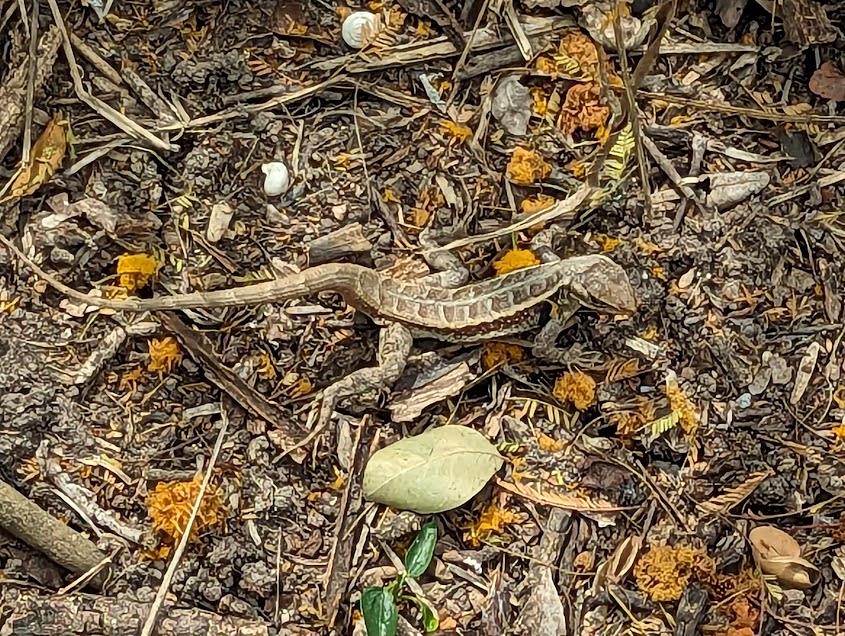A dapper male, armored in pinecone-colored scales, scurried by, then froze briefly amid limbs, twigs and yellow puffs of huisache blossoms at Santa Ana Wildlife Refuge in early March. A female popped up on crossed branches. The couple mated briefly, then dashed away into the spring foliage.
This Texas spiny lizard—also called tree or fence lizard—flourishes within a hefty swath of Texas, from the Rio Grande upwards towards Dallas, towards the lower Great Plains and west to Big Bend. And it appears to be expanding in range. Since the lizard naturally dwells along the bark of trees, the transformation of natural grasslands and farms into tree-filled neighborhoods and commercial lots appear to have abetted its growth. It also lives in scrublands along fences and among foliage and leaf litter—especially amid structures it can climb.
I’ve seen Texas spiny lizards in my backyard, along asphalt and logs and, this winter, hidden beneath a truck parked at Resaca de la Palma State Park. Oddly, I haven’t seen one upon a tree—likely because it blends in so beautifully with the bark. In some areas, almost any large tree, allegedly, harbors a Texas spiny lizard.
Those of us within its range see this reptile frequently, and our own backyards likely give it ample territory. Gardeners love these lizards, as they consume ticks, mosquitoes, flies and a wide variety of other insects and their larvae, as well as the occasional vertebrate. Plus, they inflict no harm to plants, water, soil or air. Like other members of the suborder iguania, the Texas spiny lizard, assuring it has a clear view, tends to sit and await prey. Then it either inches towards or dashes after it, often dipping downwards from tree trunks, then sprinting back up.
Besides being a fierce predator, the Texas spiny lizard provides a delicious morsel for our gray hawks—who specialize in lizard-hunting—as well as other raptors, snakes, possums and bobcats. When threatened it, like other lizards, freezes or dashes away. It often zips around to another side of a trunk or even dives into a tree’s hollow. Yet, knowledgeable lizard enthusiasts can catch and hold one with little difficulty. One fisherman who habitually casts his line in the same spot claimed to observe and greet a particular lizard on a nearby tree day after day.
One of about 100 spiny lizards—10 of them Texas residents—the Texas spiny lizard (Sceloporus olivaceus) wears striking, papery, almost feathery scales of gray or brown, blotched with black, white or reddish brown, with colors that blend in with the particular trees on which it lives. It has thick eyelids and noticeable ear holes. Blue stripes—some muted, some more apparent—line the sides of males. Its long toes and sharp claws make it adept at scaling tree trunks. A female wears black crossbands along her back and forearms. The creature’s scales are large and keeled, or have a ridge running down their centers. A sizeable lizard, it may reach a length of from 7 ½ to 11 inches.
A prolific breeder, a female produces up to four clutches a year, which may contain from 19 to 30 eggs. She lays them about three to four inches deep in a shallow burrow. Hatchlings are about 2 ½ inches long.
A male desiring to mate performs push-ups, as does the female, to a lesser degree. He bites her, then hangs on for a while, and their tails entwine. Being quite territorial, the male defends his chosen tree from competitors, doing push-ups as a threat.
These lizards may sit for 10 to 30 minutes, but then speed off to either secure prey or keep from becoming it. We see them most often from March to late October. In cooler climates, they brumate in the winter, or undergo a dormant period, nestling underneath a two-inch carpet of leaves. Here, they do hunker down when it’s cold, but we may see them basking in the sun or find them underneath cars, boards or sheet metal.
While the Texas spiny lizard’s range expands, it appears to be involved in a turf war with its genus-mate and fellow Valley resident, the smaller prairie lizard (Sceloporus consobrinus) where the two species converge. Placed together, the smaller species runs off and hides. A recent study at the University of Texas in Arlington revealed that in places where Texas spiny lizards are expanding, numbers of prairie lizards are decreasing.
The Texas spiny lizard, with its broad diet and gentle manner, is a good terrarium resident, but since it’s on the Texas Parks and Wildlife Department’s Black List, reptile enthusiasts cannot collect it from the wild. They must purchase the lizard from a licensed nongame permit holder or out-of-state source.


